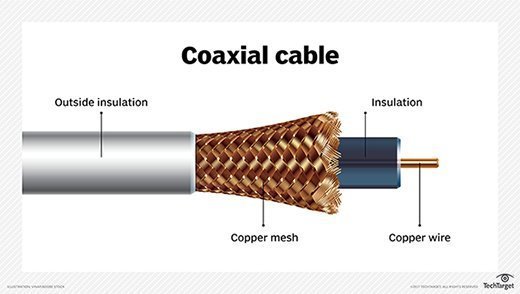Coaxial cable is a widely used transmission line for carrying signals in telecommunications, cable television, internet connections, and other electronic applications. It is known for its superior shielding capabilities, which reduce interference and enhance signal quality. This article explores the structure, types, uses, advantages, and limitations of coaxial cables.

Structure of Coaxial Cable
A coaxial cable consists of the following layers:
- Inner Conductor: Usually made of copper or aluminum, this core carries the electrical signal.
- Dielectric Insulator: Surrounds the inner conductor, preventing signal leakage and maintaining signal integrity.
- Shielding Layer: Typically composed of metallic foil or braided wire, this layer reduces electromagnetic interference (EMI).
- Outer Jacket: Provides mechanical protection and insulation for the internal components.
Types of Coaxial Cables
Coaxial cables come in various types, each suited for specific applications. The most common types include:
1. Hardline Coaxial Cable
- Used for high-frequency applications like broadcasting and radio transmitters.
- Features a robust design with a solid copper or aluminum core.
2. RG Coaxial Cables
- RG (Radio Guide) cables are classified based on impedance and shielding.
- RG-6: Commonly used for cable TV and satellite signals.
- RG-11: Ideal for long-distance signal transmission.
- RG-59: Frequently used in CCTV and low-frequency applications.
3. Semi-Rigid Coaxial Cable
- Offers excellent shielding and low signal loss.
- Used in aerospace and military applications.
4. Triaxial Cable (Triax)
- Has an additional insulation layer for extra protection against interference.
- Commonly used in broadcasting and professional video applications.
Applications of Coaxial Cable
Coaxial cables are used in various industries due to their reliable performance. Some key applications include:
- Television and Cable Networks: Delivers high-quality video and audio signals.
- Internet and Broadband Services: Used by ISPs for data transmission.
- Radio and Telecommunications: Supports radio transmission and cellular networks.
- Security Systems: Used in CCTV cameras and surveillance setups.
Advantages of Coaxial Cable
- High Bandwidth: Supports high-frequency signals without significant loss.
- Durability: Resistant to environmental factors, making it ideal for outdoor use.
- Interference Resistance: Shielding prevents external signal disruptions.
- Cost-Effective: Affordable compared to fiber optics in many applications.
Limitations of Coaxial Cable
- Signal Loss Over Distance: Requires amplifiers or repeaters for long-distance transmission.
- Bulkiness: Heavier and less flexible than fiber optic cables.
- Limited Speed Compared to Fiber Optics: Not as fast as fiber-optic connections for high-speed data transmission.
Conclusion
Coaxial cables remain a crucial part of modern communication systems due to their reliability and efficiency. While fiber optics are becoming more prevalent, coaxial cables continue to serve as a cost-effective solution for many applications. Understanding the different types and their uses can help in selecting the right cable for specific needs.



